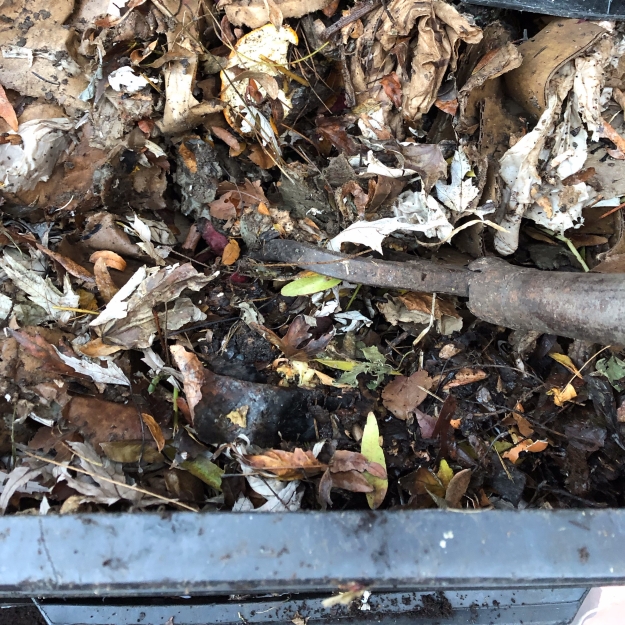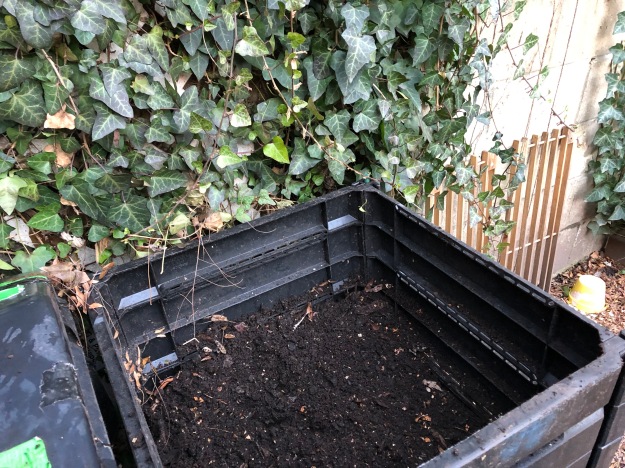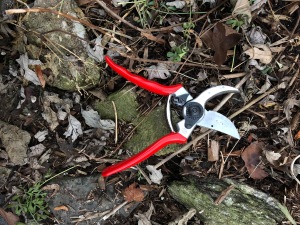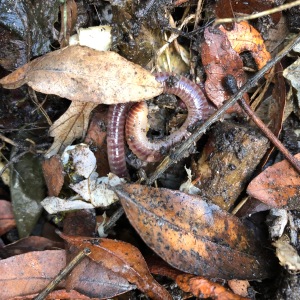 Turning the food-scrap compost. It had to be done, but first came the rain, then holiday shopping, then more rain, and a quick trip to Maine. I found myself out of sync with the compost pile. Still, I couldn’t ignore it any longer. Members of my compost team were emailing me to ask if I’d opened up a new bin yet. They were anxious to get back to composting at our garden after I’d closed up our full intake bin and sent them temporarily elsewhere. That is a good thing. Compost made in the garden stays in the garden. Gardeners dedicated to composting keep the practice strong and draw more people in. So when the Sunday before Christmas brought drier air and some sun, I set about harvesting our crumbly black compost. Our beautiful compost.
Turning the food-scrap compost. It had to be done, but first came the rain, then holiday shopping, then more rain, and a quick trip to Maine. I found myself out of sync with the compost pile. Still, I couldn’t ignore it any longer. Members of my compost team were emailing me to ask if I’d opened up a new bin yet. They were anxious to get back to composting at our garden after I’d closed up our full intake bin and sent them temporarily elsewhere. That is a good thing. Compost made in the garden stays in the garden. Gardeners dedicated to composting keep the practice strong and draw more people in. So when the Sunday before Christmas brought drier air and some sun, I set about harvesting our crumbly black compost. Our beautiful compost.

Hell’s Kitchen Compost: Made using four Garden Gourmet bins, eight or so big bags of leaves, and fresh vegetable and fruit scraps.
It was not a quiet day on the garden block. Santas drove by blasting music and delivery trucks sat in traffic honking endlessly, but in the garden I was mostly alone with birds, squirrels, and mice, and the millions of minute creatures of the compost. Making their bed in the new bin soothed me, the Gulliver in their midst, oblivious to the feverish activity they were soon to be engaged in.

It’s soft and just moist enough to hold its shape for a bit before crumbling. It smells of the earth. We’ll sift it right before we use it.
Post-Christmas, the larger, less forgiving compost project loomed in the garden-debris pile. I clomped to the garden in my work boots mid-morning on the 26th to conquer a stringy, weedy, twiggy, chunky intake bin. Some readers might be wondering why we have two separate composting areas. There are, of course, many different ways of handling compost and some systems combine both plant material and food scraps. At this garden, space has always topped the list of compost-management concerns and with it, time, on both micro and macro scales. In our food scrap–only area, four enclosed Garden Gourmet bins of black recycled plastic fit neatly into a 5′ x 7′ spot and make quick work of chopped high-nitrogen fruit, veggie, coffee, and tea remains layered with carbon-rich autumn leaves. (Catch it at the right time and you could almost cook a meal on top of the bin while yesterday’s remnants simmer below.)
Our three-bin (used to be four but that’s another story) wooden structure with removable slats is a hefty item built for dealing with plant debris from 100-plus garden plots and ornamental beds, shrubs, and trees. As such, it presents a different challenge, requiring more time, more patience, and more labor. More time because the bins are larger, more open, and so cooler; more patience because the range of plant matter breaks down at different rates and more labor because of the vines, twigs, branches, bulbs, rose canes, whole plants that must be cut and chopped and invasive weeds that need to be separated out along with the various non-organic oddities that show up in every batch. When I face the plant-debris bin, my allies are pruners little and big, a saw, steel-toed boots, gloves, a sturdy garden fork, and a blunt shovel for scooping.

Compost needs pruning too. And it’s sometimes a good way to practice. I tried out my new pair of Felcro #2 pruners. A pleasure.
By combing, raking, digging, poking, and cutting through the pile, I manage to turn it from bottom to top before the sun starts to sink. I find the pile’s hot core and it see that it is very alive indeed. I bag up the roughest and toughest stuff to give it a chance to soften before I return it to the bin. I rescue a few discarded plants and give them a home in my garden plot. I work in a couple of bags of leaves and salvage a few treasures: shells, sea glass, and some chimes that might be just right for the children’s garden bed. And suddenly there’s no more to do but sweep and close up before it’s too dark to see my way out.
On my way home, my head is full of what do with the compost when it’s done. I’m hoping for some snow cover—mid-January would be just right—so I can sift a mix of the plant debris and veggie composts over the lawn and my garden beds and let the melting snow gently deliver the goods to the soil.
Wishing a Happy 2019 to my gardening friends. If you haven’t started composting yet, I hope you make this the year you do. Send me your questions and concerns and I’ll do my best to talk you through.




